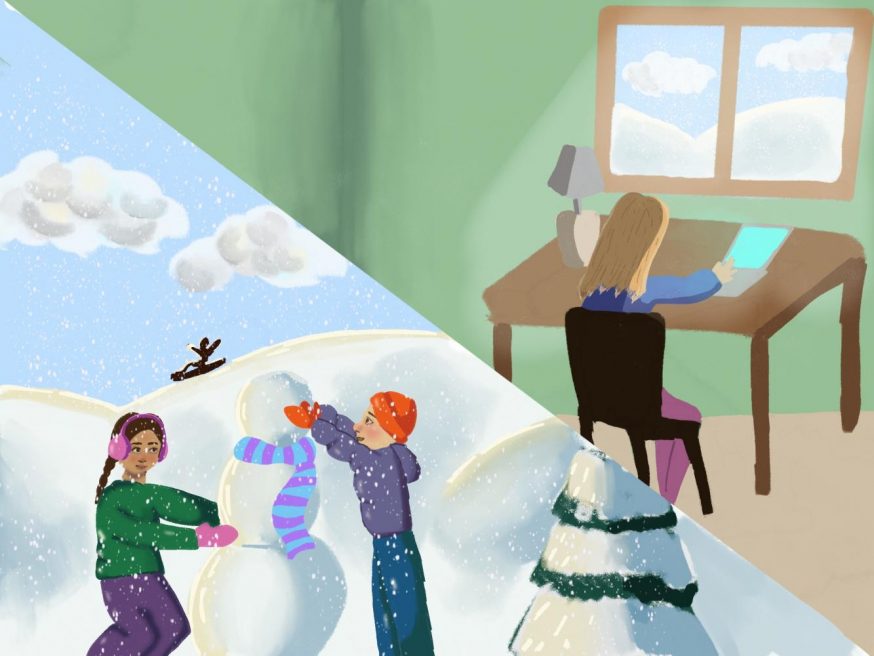Virtual snow days: should they be here to stay?
 Christiana Kirov | Conant Crier
Christiana Kirov | Conant Crier With an online school system put in place during the COVID-19 pandemic, snow days may now become a thing of the past. Some are saying that virtual learning could be used to connect students to class when the weather is bad, even after school returns to in-person learning.
District 211’s extreme weather policies call for schools to be closed when there is a wind chill advisory or when there is too much snow for buses to take kids to school buildings. Under a traditional school schedule, snow days are a source of great excitement for students, getting to stay home instead of sitting through classes. Younger students enjoy playing in the snow and most high school students appreciate the short break from the stress of class.
However, with a virtual learning system now in place, teachers can still teach from home, even when the weather is bad. Recently, on January 26th and February 16th, all District 211 extracurriculars and classes were held virtually due to extreme cold, instead of completely canceling classes. Before the pandemic, this would have been a snow day with the day off from school.
There are questions about whether this policy should be continued even after school goes back to full in-person. I disagree with this course of action as there are far too many drawbacks.
There are some benefits to keeping these policies. Students and teachers are able to stay on track with the curriculum and not miss a day of school. There is no catch up needed when school returns. Important events, like tests and extracurricular activities, can also stay on track and avoid being delayed.
Keeping up with snow days also prevents schools from tacking on extra days at the end of the school year. Students would be able to avoid having a couple extra days eat into their summer vacation.
Despite these benefits, I believe the drawbacks are much larger. A big issue is technology. There are still issues such as Internet connectivity, figuring out how to use Zoom, and making sure everything goes smoothly in general.
Even after almost a year of virtual school, students and teachers alike are still working out certain technology issues. One day of virtual classes would be almost pointless, as much of the day would likely be spent setting up video meetings and other housekeeping tasks that come with a new learning environment.
Younger children and brand-new teachers would have to figure out how to navigate new technology. Many of us have seen our elementary school siblings struggle with connecting to a Zoom meeting on time or have trouble focusing during a particularly long online lesson. It would be difficult for young children to focus from home, especially if they have never done virtual learning before.
There is also the issue of accessibility. Many students don’t have access to stable internet or devices for distance learning. According to a U.S. Census Bureau survey, 4.4 million U.S. households with children lack stable access to computers and 3.7 million lack internet access, as of September 2020. Even students’ Internet speed would likely be affected during snow storms. Many districts, including District 211, have set up procedures for disadvantaged students to receive hotspots, iPads, laptops, and other necessary devices for long term distance learning.
This would not be possible to execute in a snow day situation, where students would only be out of school for one day. More often than not, snow days are spontaneous, announced the night before or the morning of. Even if there was an anticipated snow day, there would still be no time to organize and distribute devices to students before class.
In a normal school year, there is no infrastructure set up for completely virtual classes. Hotspots and other devices aren’t distributed under normal circumstances. It is inequitable for students who have access to the Internet and devices to be able to connect to school while those who don’t have access aren’t able to. Students would return to school behind their classmates and would have to work harder to catch up simply because their circumstances didn’t allow them to access school.
While virtual snow days do have advantages from an administrative perspective, they are not best for students. Focusing from home for one day and navigating technology will be an issue for many students. There is significant inequity in terms of Internet reliability and access to devices able to support Zoom. Lastly, snow days are a long-cherished tradition by many. There is nothing like the anticipation felt the night before, with the constant checking of weather reports and waiting for that coveted call from the school. To students, snow days are meant to be short, fun breaks from school and they should stay that way.
Let the Crier know in the comments below if you agree that snow days should stay the way they are or if you think virtual classes for any missed days are the way to go!




We should not attend school virtually during the snow days.
NO! Even if you do I am not showing up for any of these virtual snow days anytime in the future. If you want to take take away snow days, then I want you to think of the snow days you got to enjoy when you were younger.